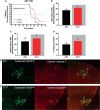Circadian Influences on Chemotherapy Efficacy in a Mouse Model of Brain Metastases of Breast Cancer
- PMID: 34956876
- PMCID: PMC8695439
- DOI: 10.3389/fonc.2021.752331
Circadian Influences on Chemotherapy Efficacy in a Mouse Model of Brain Metastases of Breast Cancer
Abstract
Chemotherapy is more effective in the treatment of peripheral tumors than brain metastases, likely reflecting the reduced ability of chemotherapy to cross the blood-brain barrier (BBB) and blood-tumor barrier at efficacious concentrations. Recent studies demonstrate circadian regulation of the BBB. Thus, we predicted that optimally timed chemotherapy would increase anti-tumor efficacy in a model of brain metastases of breast cancer (BMBC). First, we characterized novel daily alterations in BBB permeability to a commonly used chemotherapeutic, 14C-paclitaxel, within BMBC following injections given at four time points across the day. Peak and trough 14C-paclitaxel concentrations within BMBC occurred during the mid-dark phase and at the beginning of the light phase, respectively. Notably, chemotherapy injections during the dark phase increased cell death within BMBC and delayed onset of neurological symptoms relative to injections during the light phase. These data provide strong evidence for the beneficial effects of chrono-chemotherapy for the treatment of BMBC.
Keywords: blood-brain barrier; brain metastases; breast cancer; chronotherapeutic; circadian rhythm.
Copyright © 2021 Walker, Sprowls, Bumgarner, Liu, Meléndez-Fernández, Walton, Lockman, DeVries and Nelson.
Conflict of interest statement
The authors declare that the research was conducted in the absence of any commercial or financial relationships that could be construed as a potential conflict of interest.
Figures




Similar articles
-
The structure of blood-tumor barrier and distribution of chemotherapeutic drugs in non-small cell lung cancer brain metastases.Cancer Cell Int. 2021 Oct 24;21(1):556. doi: 10.1186/s12935-021-02263-6. Cancer Cell Int. 2021. PMID: 34689774 Free PMC article.
-
A Therapeutic Sheep in Metastatic Wolf's Clothing: Trojan Horse Approach for Cancer Brain Metastases Treatment.Nanomicro Lett. 2022 Apr 28;14(1):114. doi: 10.1007/s40820-022-00861-1. Nanomicro Lett. 2022. PMID: 35482117 Free PMC article.
-
Blood-tumor barrier opening by MRI-guided transcranial focused ultrasound in a preclinical breast cancer brain metastasis model improves efficacy of combinatorial chemotherapy.Front Oncol. 2023 Feb 10;13:1104594. doi: 10.3389/fonc.2023.1104594. eCollection 2023. Front Oncol. 2023. PMID: 36845739 Free PMC article.
-
Efaproxiral: GSJ 61, JP 4, KDD 86, RS 4, RSR 13.Drugs R D. 2005;6(3):178-85. doi: 10.2165/00126839-200506030-00007. Drugs R D. 2005. PMID: 15869322 Review.
-
Actual, Personalized Approaches to Preserve Cognitive Functions in Brain Metastases Breast Cancer Patients.Cancers (Basel). 2022 Jun 25;14(13):3119. doi: 10.3390/cancers14133119. Cancers (Basel). 2022. PMID: 35804894 Free PMC article. Review.
Cited by
-
Chronotherapeutics for Solid Tumors.Pharmaceutics. 2023 Jul 26;15(8):2023. doi: 10.3390/pharmaceutics15082023. Pharmaceutics. 2023. PMID: 37631237 Free PMC article. Review.
-
Prognostic value of circadian rhythm-associated genes in breast cancer.World J Surg Oncol. 2025 May 14;23(1):186. doi: 10.1186/s12957-025-03829-8. World J Surg Oncol. 2025. PMID: 40369575 Free PMC article.
-
The role of cryptochrome (CRY) in cancer: molecular mechanisms and clock-based therapeutic strategies.Acta Biochim Biophys Sin (Shanghai). 2025 Mar 19;57(7):1037-1046. doi: 10.3724/abbs.2025025. Acta Biochim Biophys Sin (Shanghai). 2025. PMID: 40109093 Free PMC article. Review.
-
Time of day bias for biological sampling in studies of mammary cancer.Sci Rep. 2024 Jan 8;14(1):848. doi: 10.1038/s41598-023-50785-y. Sci Rep. 2024. PMID: 38191908 Free PMC article.
-
Circadian rhythms in the blood-brain barrier: impact on neurological disorders and stress responses.Mol Brain. 2023 Jan 12;16(1):5. doi: 10.1186/s13041-023-00997-0. Mol Brain. 2023. PMID: 36635730 Free PMC article. Review.
References
-
- Mukherji A, Kobiita A, Damara M, Misra N, Meziane H, Champy MF, et al. . Shifting Eating to the Circadian Rest Phase Misaligns the Peripheral Clocks With the Master SCN Clock and Leads to a Metabolic Syndrome. Proc Natl Acad Sci USA (2015) 112:E6691–8. doi: 10.1073/pnas.1519807112 - DOI - PMC - PubMed
Grants and funding
LinkOut - more resources
Full Text Sources

